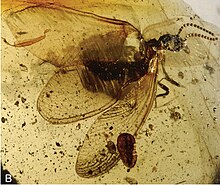Parastylotermes
|
Parastylotermes Temporal range: Ypresian - Miocene |
|
|---|---|
 |
|
| P. krishnai holotype | |
| Scientific classification | |
| Kingdom: | Animalia |
| Phylum: | Arthropoda |
| Class: | Insecta |
| Order: | Blattodea |
| Family: | Stylotermitidae |
| Genus: |
†Parastylotermes Snyder and Emerson, 1949 |
| Species | |
|
|
Parastylotermes is an extinct genus of termite in the Isoptera family Stylotermitidae known from North America, Europe, and India. The genus contains five described species, Parastylotermes calico, Parastylotermes frazieri, Parastylotermes krishnai, Parastylotermes robustus, and Parastylotermes washingtonensis.
Parastylotermes was first described by entomologists Thomas E. Snyder and Alfred E. Emerson in the 1949 paper Catalog of the termites (Isoptera) of the world. Prior to 1949, both P. washingtonensis and P. robustus were placed in separate modern species. Snyder and Emerson placed Parastylotermes in Stylotermitidae, which at that time was considered a subfamily, Stylotermitinae, of the family Rhinotermitidae.
P. robustus was the first species to be described, having been published by Baron Kurt von Rosen as Leucotermes robustus in 1913. Fossils of the species were recovered from the Middle Eocene, Lutetian, "Blue Earth" Baltic amber deposits, with three imagos and four isolated wings known. Of the five known specimens, the original type series of fossils that von Rosen used in describing the species were held in the Bayerische Staatssammlung für Paläontologie und Geologie collections and are thought destroyed during World War II. Von Rosen noted in his type description of the species that he was uncertain of its genus placement. Since then the species has been moved several first to Leucotermes (Reticulitermes) robustus, then to Reticulitermes robustus when Reticulitermes was changed from a subgenus to a full genus. Finally the species was transferred to Parastylotermes by Snyder and Emerson in 1949. P. robustus and P. krishnai are the only two species which are known from more than isolated wings.P. robustus can be distinguished from P. washingtonensis by is age and its shorter, wider, wings which are estimated to be 9.40 by 3.17 millimetres (0.370 by 0.125 in).
...
Wikipedia
